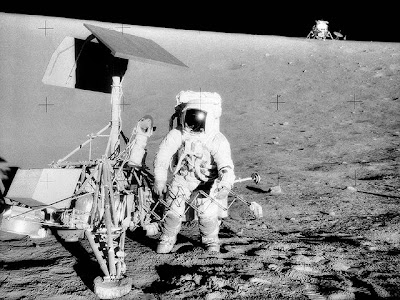Date: November 14-24, 1969
Crew: Commander Pete Conrad (39)
Command Module Pilot Dick Gordon (40)
Lunar Module Pilot Alan Bean (37)
Command Module Call Sign: Yankee Clipper
Lunar Module Call Sign: Intrepid
Mission Distinctions: Second manned lunar landing, in which a sophisticated geophysical station was set up, as well as a nuclear power station.
Moon Landing Site: Oceanus Procellarum

Richard Nixon became the first president to witness a manned launch; seconds after the crowd watched the Apollo 12 stack disappear into the clouds, lightning flashed all around, and at least two bolts hit the spacecraft, but luckily did not interfere with its ability to achieve TLI (translunar injection).
The lightning did, however, take all fuel cells offline, putting the CSM only on batteries. Various circuits, attitude indicators and AC inverters malfunctioned, lighting up nearly every warning diode on their panels. Mission Control advised Alan Bean how to get systems back online, avoided a mission abort.
Upon the ladder descent to the lunar surface, Conrad remarked, "That may have been a small step for Neil, but it’s a long one for me!" (Neil Armstrong was 5'11" tall and Conrad was only 5'8")
Apollo 12 landed only 535 feet from the Surveyor III, which had landed on the Moon about two and a half years earlier to take photographs and soil samples.

Conrad with Surveyor 3 (LM in background)
Major mission Oops! The television camera sending pictures back to Earth was inadvertently pointed toward the sun and ruined. For the rest of the mission, controllers and the public relied upon the astronauts’ simply describing what they were seeing and doing.
Currently, the Apollo 12 command module is on display at the Air & Space Center in Hampton, Virginia. The ascent stage of the lunar module Intrepid impacted the moon at 3.94 S, 21.20 W, on November 20, 1969. The descent stage is still in the "Ocean of Storms."


































































